Quick Look: Kingston HyperX MAX 3.0, A USB 3.0 V+100 SSD
by Anand Lal Shimpi on November 24, 2010 1:28 PM ESTAlthough OCZ was first on the market with a USB 3.0 enabled SSD with its Enyo drive, competitors are knocking down the doors and bridging the gap. We saw the first lower cost USB 3.0 SSD with Kingston's DataTraveler Ultimate 3.0, however the JMicron JMF612 controller it was based on didn't really impress. The only thing the DataTraveler Ultimate 3.0 had going for it was a lower total cost for the smaller capacity versions.
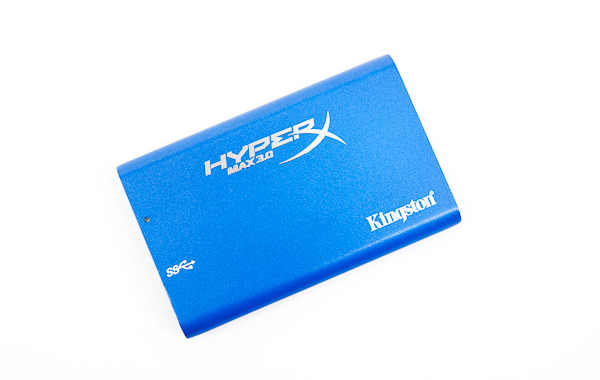
The sole LED on the HyperX MAX 3.0 turns green when running in USB 2.0 mode, blue when in 3.0 mode
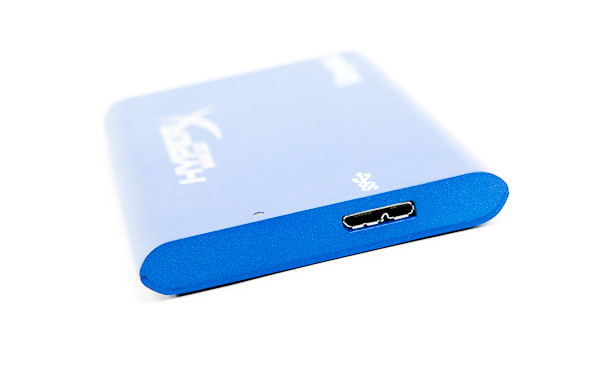
The drive comes with a USB 3.0 cable, don't lose it as there's no USB 2.0 port
Hot on the heels of the release of its unusually potent V+100 SSD, Kingston aims its sights at the high end with its second USB 3.0 SSD: the HyperX MAX 3.0. Borrowing a brand from Kingston's enthusiast memory line, the HyperX MAX 3.0 is literally a SSDNow V+100 SSD paired with a SATA to USB 3.0 bridge PCB:
The blue PCB is near identical to what we saw in the V+100 we reviewed:
Except in this case it plugs into a secondary PCB that bridges the 3Gbps SATA interface to a USB 3.0 interface:
The end result is an external SSDNow V+100 for those who want to carry around a decent amount of data and want very fast access to it.The HyperX MAX 3.0 uses the same Toshiba T6UG1XBG controller from the V+100. In our review of that SSD I found the new Toshiba controller actually did very well in real world workloads as well as maintaining sequential write speed even when peppered with random data. I originally attributed its behavior to a very aggressive garbage collection policy, however there may be other elements of Toshiba's architecture at work here (more on this in an upcoming article, hopefully).
The V+100 is probably the best platform you can think of today for an external SSD because its performance is so resilient. I took the HyperX MAX 3.0, filled it to its capacity, then wrote random data at a queue depth of 32 IOs across the entire drive for 20 minutes. While this process tanked random write speed on the drive, sequential performance was nearly untouched:
What this means is that under normal use as an external drive, it doesn't really matter what you copy to the drive or how often you use it. The drive won't lose sequential read or write performance - you'll still be able to copy movies, photos or whatever large files you've got at full speed. In fact, the worst I ever saw performance drop to was ~135MB/s after a bunch of random writing. After less than an hour of idle time the drive was back up to writing at full speed again across the entire drive.


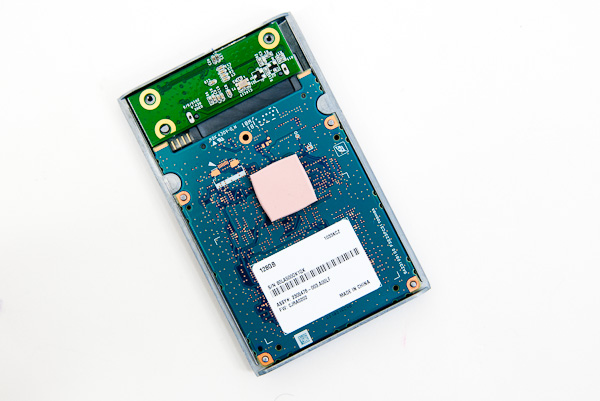

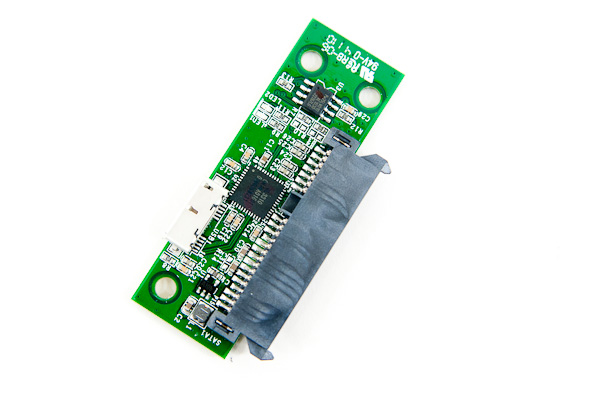
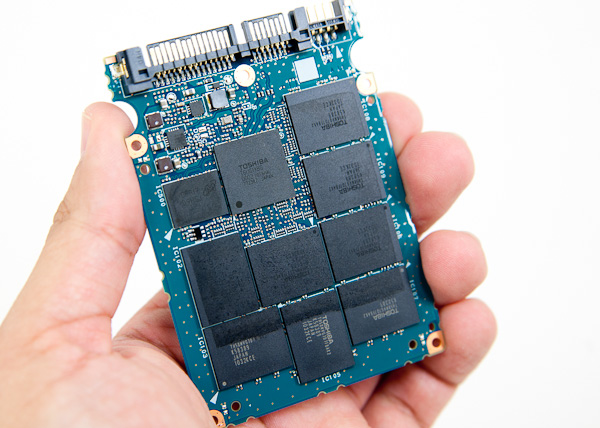
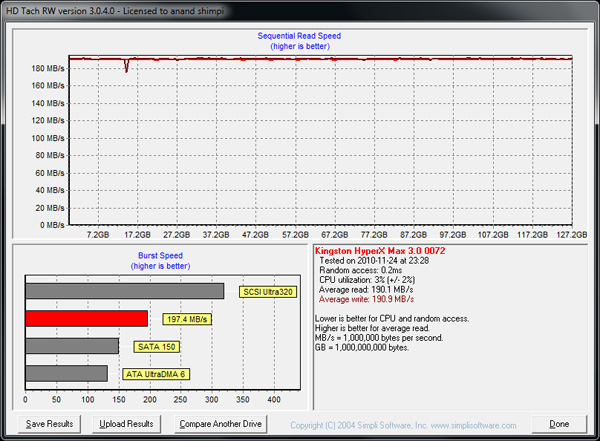
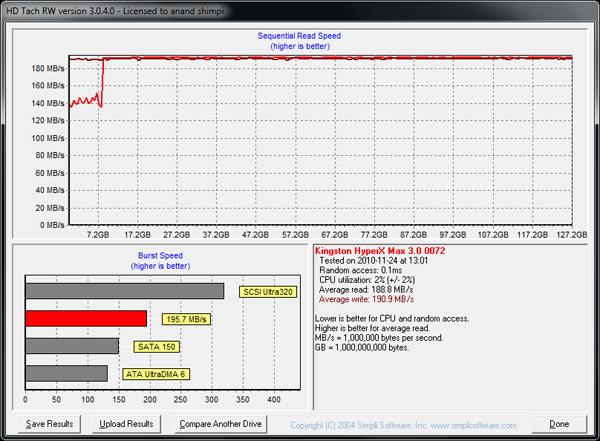








30 Comments
View All Comments
Chloiber - Wednesday, November 24, 2010 - link
The drive looks great - allthough I think it's still cheaper, better (and really easy) to just go with a custom setup if you really need the speed.Probably the same performance, but it's cheaper (alltough I'm not that sure because external USB 3.0 cases like the Lian Li EX-10QB are still pretty expensive) and you can also exchange the SSD later.
It looks very slim though, nothing to complain about there. I also agree with your conclusion: sequential performance and performance resiliency are way more important than random performance on an external drive.
vailr - Wednesday, November 24, 2010 - link
Unless I'm mistaken, it's still not possible to create a Windows bootable external USB 3.0 (or: USB 2.0) drive, without first creating your own custom Windows install disc. But OSX is easier for such a purpose.bji - Wednesday, November 24, 2010 - link
Also Linux has no problem booting from an external drive.SandmanWN - Wednesday, November 24, 2010 - link
Thats why we have eSATA people.bigboxes - Wednesday, November 24, 2010 - link
Be honest. eSATA is dying. USB 3.0 will ensure that. There there... death will come quickly.SandmanWN - Thursday, November 25, 2010 - link
Yeah, everyone loves having cpu overhead being devoted to transfer protocol decoding, the added costs of additional chips on their motherboards, having to support yet another set of incompatible ports on the back of their crowded interface panel. I mean really, who would ever want a system that directly speaks to the same bus that every other hard drive uses. Then again this is the new era of computing where choosing a catchy name is always better than choosing the better platform. That's just the way we do it these days.Chloiber - Wednesday, November 24, 2010 - link
I'm not sure if I didn't understand your comment correctly, but it's possible to boot from an external USB drive with Windows.name99 - Wednesday, November 24, 2010 - link
I've no idea what the situation is with Windows, but any modern Mac (intel and I think even some of the late PPC models) can boot off USB.I run my (2007 Penryn) iMac off an external USB SSD, using the internal drive for movies and music, and it works really well --- the improvement in responsiveness, even with a USB2 connection, is very obvious.
[And why don't I run it off an FW800 SSD you ask? Because of the problem indicated in my next comment. Current SSDs draw a lot of power. This power is within the spec of FW800, but the crappy FW800 enclosure I got from crappy AcomData doesn't fully support the spec and can't deliver this power.
I am sick of dealing with AcomData and am not willing to waste my money on another enclosure that, for all I know, is as bad as or worse than AcomData's.]
marraco - Thursday, November 25, 2010 - link
You mean the crappy computer you got from the fruity company.All that rant about Windows is false.
Sufo - Thursday, November 25, 2010 - link
Can you not just swap the internal drive with the SSD? I know imacs aren't exactly easy to dismantle, but running your OS off an external drive seems like utter lunacy to me. The concept of having a machine that can't boot without a peripheral connected seems downright insane. At least it wasn't a notebook...also "Current SSDs draw a lot of power." do they?